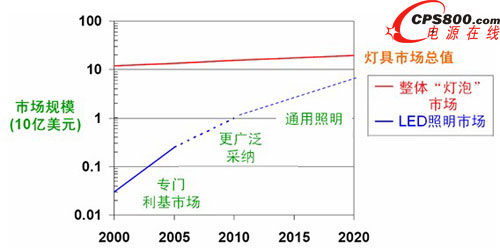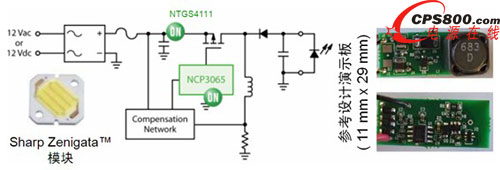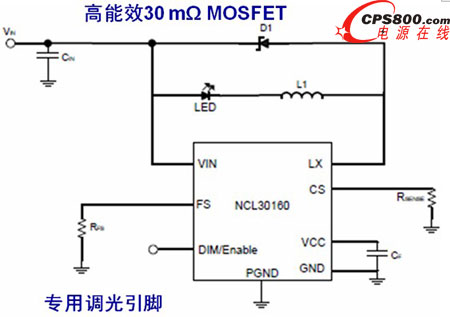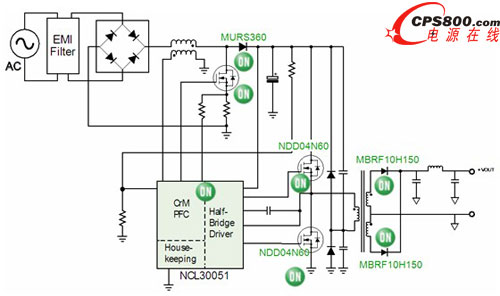As energy prices continue to rise and environmental problems increase, countries around the world are committed to reducing greenhouse gas emissions and accelerating the pace of replacing environmentally harmful compact fluorescent lamps (CFL) and linear fluorescent lamps (LFL) with LEDs. So far, many countries and regions in the world have announced timetables and roadmaps for the "retirement" of incandescent lamps. China's plan to ban (ban the sale of) incandescent lamps was also released recently. The National Development and Reform Commission and other departments jointly issued the "Notice on the Gradual Ban on the Import and Sale of Ordinary Incandescent Lamps", deciding to gradually ban the import and sale of ordinary incandescent lamps in stages according to power size starting from October 1, 2012.
LED has become the key driving force of the lighting revolution with its longer life, excellent color combination, energy saving and environmental protection. In recent years, LED has become one of the fastest growing semiconductor markets, with a five-year compound annual growth rate of 19.3%. It is expected that the total market value will reach US$12.4 billion in 2013, as shown in Figure 1.

Figure 1: LED market growth drivers and trends
The light output, energy efficiency and cost of high-brightness LEDs are improving rapidly, which has led to a continuous expansion of their application scope. According to the operating voltage of LEDs, they can be divided into three power levels: 0.9V to 7V (mobile phones and mobile devices), 7V to 60V (automobiles and LCD backlights) and 60V to 700V (general lighting). Among these, the markets with the greatest growth potential are automobiles, LCD backlights and general lighting. Automotive applications mainly include neon lamp replacement, emergency vehicle lights, combination taillights, instrument panel lighting, infotainment, interior lighting, central high-mounted brake lights, headlights, parking lights, etc.; LCD backlights mainly include large-screen LCD TVs, medium-screen notebooks, GPS, photo frames, netbooks, etc.; general lighting mainly includes offline LED drivers/ballasts, street/area lighting, replacement bulbs, replacement fluorescent lamps, traffic lights, work lighting, landscape lighting, building lighting, etc. It is not difficult to see that LED lighting will gradually enter more application areas in the future.
ON Semiconductor's energy-efficient LED lighting solutions
Using advanced technology to perform the same or even more tasks with less power and further improve energy efficiency has always been the unremitting pursuit of ON Semiconductor. ON Semiconductor has developed a wealth of products and solutions for high-efficiency LED applications, which can meet the various challenges of LED lighting applications, such as increasing power density, achieving power factor correction, improving overall reliability, wider input power range, meeting space constraints and specific lighting requirements (such as triac dimming), etc.
ON Semiconductor's broad product range includes AC-DC power supply ICs, DC-DC drivers, CCR current regulators, CCCV control, HV-FETs, rectifiers, digital interfaces, ambient light sensors, protection, power line carrier (PLC) modems, etc.
ON Semiconductor continues to innovate and launch LED general lighting application solutions, fully embodying the characteristics of high energy efficiency, innovation and robustness.
Medium and low power LED lighting applications
MR16 bulbs are typical in low- and medium-power LED lighting applications. The design challenge is to provide a relatively flat output current under different AC voltage conditions and provide excellent energy efficiency under different DC conditions. ON Semiconductor's buck-boost NCP3065 switching regulator uses a bridge rectifier for AC-DC conversion, with wide input and output operating voltages and stable output current. The NCP3065 can be configured as a buck-boost to meet the requirements of overlapping input and output voltages, and has open and short-circuit LED protection functions, which can be dimmed by a 12 Vac electronic transformer/wall dimmer. The internal reference voltage of the NCP3065 is fine-tuned to 2%, thereby providing extremely precise and stable current even under wide variations in input voltage, LED forward voltage, and inductance tolerance.

Figure 2: MR16 LED bulb circuit and reference design using NCP3065
Another MR16 LED solution is the NCL30100 for buck applications. It is an LED driver controller with an efficiency of more than 95%, a switching frequency of up to 700kHz, no output capacitor required, and a Vcc operating range of 6.35 to 18 V. It can drive one or more high-power LEDs and is mainly used in MR16 LED lighting, ambient lighting, solar LEDs, traffic lighting, outdoor lighting, and LED light strips. Its PCB is very small and can be installed in the lamp holder of an MR16 lamp. The hysteresis control feature of the NCL30160 provides a fast response during load transients without the need for small signal control loop compensation components. Protection features include resistor-settable LED current, LED short-circuit protection, undervoltage lockout, and thermal shutdown.

Figure 3: MR16 LED bulb circuit and reference design using NCL30100
ON Semiconductor's other LED drivers include the NCL30000, an offline driver with PFC and TRIAC dimming compatibility, which can achieve more than 80% efficiency (typically 83%) under low-level conditions of 5 to 15 W output power, suitable for LED drivers/ballasts, recessed lights/spotlights/outdoor lighting; AC-DC isolated power supply solutions for LED lighting, suitable for 3 to 8 W low-power lighting, 8 to 40 W recessed lights and PAR bulbs, as well as 40 to 125 W building and area lighting and 50 to 300 W high-efficiency LED street lighting.
High power lighting applications
NCL30160 is a new NFET hysteresis buck, constant current driver launched by ON Semiconductor for driving high-power LEDs. It is a new generation of high-efficiency solutions with a current of 1.5 amps, very low losses, and a smaller size to minimize space and cost. It can provide an energy efficiency of up to 98% by utilizing a low on-resistance internal MOSFET of only 55mΩ and the ability to operate at 100% duty cycle. The high switching frequency of up to 1.4MHz allows designers to use smaller external components, minimize circuit board size and minimize costs.

Figure 4: High-brightness LED driver NCL30160 application circuit
Another dedicated LED power IC is the NCL30051, which can provide a constant voltage for a step-down DC-DC converter/LED driver. The device integrates a critical conduction mode (CrM) PFC controller and a half-bridge resonant controller, and has a built-in 600V driver. It is optimized for offline power applications and has all the features required to achieve high-efficiency, small form factor design.
The LED lighting chipset composed of NCL30051 and NCL30160 can simplify the power circuit design with the minimum required external components. This architecture enables the chipset to be integrated into a more compact and cost-effective LED lighting power supply. In addition to being used in general lighting outdoor lighting (such as street lights, parking lot lights) applications, it can also be widely used in industrial and automotive lighting applications.
Other lighting applications and reference designs
ON Semiconductor also provides a variety of reference design power supplies for various lighting applications. In addition to the MR16 LED bulb reference design demonstration board mentioned above, there is also a new low-cost line-dimmable LED T5 tube reference design that can achieve direct AC drive of CCR LEDs with only 5 components; a desk lamp redesigned with LED modules, which has a higher light output than halogen lamps and consumes only 1/4 of the energy; and an offline LED driver with PFC using NCL30000 that is compatible with TRIAC dimming and is widely used in recessed lights/spotlights/outdoor lighting.
ON Semiconductor will also launch a high-power (100 to 250 W) LED driver reference design based on the NCL30051 for LED street and architectural lighting applications. The design features output open and short circuit, over-temperature, over-current (auto-recovery) and over-voltage input (OVP high voltage) protection. It can also perform two-stage dual-level analog dimming or PWM dimming (frequency 100 to 300Hz). Its dimming range is greater than 10:1; the analog voltage input is 1-10 V. Samples of this high-power lighting application solution will be available in the first quarter of 2012.

Figure 5: 100 to 250 W high-power LED driver reference design based on NCL30051
Leading energy-efficient solutions to meet various applications
ON Semiconductor uses its core expertise and advantages in power management, high-efficiency power supplies and packaging to develop dedicated LED drivers for different applications and launch solid-state lighting solutions that meet or exceed regulatory requirements around the world. These solutions use unique LED driver power architecture, analog and dimming technology, flyback converters and non-isolated DC-DC topology, as well as patent-pending self-biased transistor technology. The application range is very wide, from portable battery-powered products to automotive interior lighting, to general lighting, and architectural solid-state lighting. Whether the product is directly powered by AC or DC lines, it can be used, providing a wealth of options for realizing the lighting revolution.
Previous article:Characteristics and suppression methods of electrical fast pulse group interference in wind and solar high voltage inverters
Next article:Causes and preventive measures of inverter overvoltage
- Popular Resources
- Popular amplifiers
- MathWorks and NXP Collaborate to Launch Model-Based Design Toolbox for Battery Management Systems
- STMicroelectronics' advanced galvanically isolated gate driver STGAP3S provides flexible protection for IGBTs and SiC MOSFETs
- New diaphragm-free solid-state lithium battery technology is launched: the distance between the positive and negative electrodes is less than 0.000001 meters
- [“Source” Observe the Autumn Series] Application and testing of the next generation of semiconductor gallium oxide device photodetectors
- 采用自主设计封装,绝缘电阻显著提高!ROHM开发出更高电压xEV系统的SiC肖特基势垒二极管
- Will GaN replace SiC? PI's disruptive 1700V InnoMux2 is here to demonstrate
- From Isolation to the Third and a Half Generation: Understanding Naxinwei's Gate Driver IC in One Article
- The appeal of 48 V technology: importance, benefits and key factors in system-level applications
- Important breakthrough in recycling of used lithium-ion batteries
- Innolux's intelligent steer-by-wire solution makes cars smarter and safer
- 8051 MCU - Parity Check
- How to efficiently balance the sensitivity of tactile sensing interfaces
- What should I do if the servo motor shakes? What causes the servo motor to shake quickly?
- 【Brushless Motor】Analysis of three-phase BLDC motor and sharing of two popular development boards
- Midea Industrial Technology's subsidiaries Clou Electronics and Hekang New Energy jointly appeared at the Munich Battery Energy Storage Exhibition and Solar Energy Exhibition
- Guoxin Sichen | Application of ferroelectric memory PB85RS2MC in power battery management, with a capacity of 2M
- Analysis of common faults of frequency converter
- In a head-on competition with Qualcomm, what kind of cockpit products has Intel come up with?
- Dalian Rongke's all-vanadium liquid flow battery energy storage equipment industrialization project has entered the sprint stage before production
- Allegro MicroSystems Introduces Advanced Magnetic and Inductive Position Sensing Solutions at Electronica 2024
- Car key in the left hand, liveness detection radar in the right hand, UWB is imperative for cars!
- After a decade of rapid development, domestic CIS has entered the market
- Aegis Dagger Battery + Thor EM-i Super Hybrid, Geely New Energy has thrown out two "king bombs"
- A brief discussion on functional safety - fault, error, and failure
- In the smart car 2.0 cycle, these core industry chains are facing major opportunities!
- The United States and Japan are developing new batteries. CATL faces challenges? How should China's new energy battery industry respond?
- Murata launches high-precision 6-axis inertial sensor for automobiles
- Ford patents pre-charge alarm to help save costs and respond to emergencies
- New real-time microcontroller system from Texas Instruments enables smarter processing in automotive and industrial applications
- Microcontroller programming using C library functions
- Design of large LED display system based on FPGA+MCU
- Code protection feature of TI MSP430
- Detailed explanation of STM32 startup file
- A Engineer's Guide to Instrumentation Amplifiers
- Are the functions of the interrupt flag and interrupt pending flag repeated in the interrupt handling mechanism of the STM32 microcontroller?
- The role of bolt RFID
- A complete introduction to voltage stabilization, voltage regulation, monitoring, and DC/DC chips
- Making CH224K board
- [SAMR21 New Gameplay] 4. The First Graphical Programming Example

 Chip Manufacturing: A Practical Tutorial on Semiconductor Process Technology (Sixth Edition)
Chip Manufacturing: A Practical Tutorial on Semiconductor Process Technology (Sixth Edition)
















 京公网安备 11010802033920号
京公网安备 11010802033920号